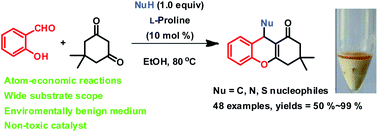Facile construction of densely functionalized 4H-chromenes via three-component reactions catalyzed by l-proline†
Abstract
Three-component reactions of salicylaldehydes, 1,3-cyclohexanediones and a sulfur, carbon, or

* Corresponding authors
a
Institute of Physical Chemistry and Industrial Catalysis, School of Chemistry and Chemical Engineering, Hubei Key Laboratory of Material Chemistry and Service Failure, Huazhong University of Science and Technology (HUST), 1037 Luoyu Road, Hongshan District, Wuhan 430074, China
E-mail:
klgyl@hust.edu.cn
Fax: +(0)86-(0)27-87 54 45 32
b State Key Laboratory for Oxo Synthesis and Selective Oxidation, Lanzhou Institute of Chemical Physics, Lanzhou, P.R. China
Three-component reactions of salicylaldehydes, 1,3-cyclohexanediones and a sulfur, carbon, or

 Please wait while we load your content...
Something went wrong. Try again?
Please wait while we load your content...
Something went wrong. Try again?
M. Li, B. Zhang and Y. Gu, Green Chem., 2012, 14, 2421 DOI: 10.1039/C2GC35668F
To request permission to reproduce material from this article, please go to the Copyright Clearance Center request page.
If you are an author contributing to an RSC publication, you do not need to request permission provided correct acknowledgement is given.
If you are the author of this article, you do not need to request permission to reproduce figures and diagrams provided correct acknowledgement is given. If you want to reproduce the whole article in a third-party publication (excluding your thesis/dissertation for which permission is not required) please go to the Copyright Clearance Center request page.
Read more about how to correctly acknowledge RSC content.
 Fetching data from CrossRef.
Fetching data from CrossRef.
This may take some time to load.
Loading related content
